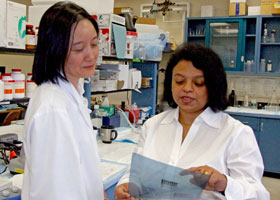Feature Story
Health Center Today, September 22, 2009
Health Center Researchers Find Combination Gene Therapy Effective in Healing Hearts
Preclinical Study Published in the Journal Diabetes Offers Hope to Diabetes Type 1 Patients
By Carolyn Pennington

Nilanjana Maulik talking with her research assistant Lijun Zhan in the Molecular Cardiology and Angiogenesis Laboratory.
Researchers at the University of Connecticut Health Center have found in preclinical studies that damaged diabetic hearts can be repaired using combination gene therapy - adenoviral VEGF (vascular endothelial growth factors) and Ang-1 (angiopoietin-1). The study is published in the current issue of Diabetes, a journal of the American Diabetes Association.
Professor Nilanjana Maulik has studied myocardial angiogenesis (the formation of new blood vessels from pre-existing blood vessels) for much of her nearly 20 year career at the Health Center. Maulik and her fellow researchers in the Molecular Cardiology and Angiogenesis Laboratory have been focusing on unique ways of repairing hearts damaged by ischemia (low oxygen levels due to the obstruction of an arterial blood supply).
"In diabetes, there is impairment of myocardial angiogenesis – decreased vessel formation in the heart which leads to decreased blood flow and eventually to heart failure," explains Maulik. "This may be one of the reasons why diabetic individuals who develop ischemic heart disease are usually given a more unfavorable prognosis for survival than ischemic heart disease patients without diabetes." The decrease in blood vessel formation is mainly due to the imbalance in growth factors such as VEGF and Ang-1, along with other factors such as oxidative stress due to the hyperglycemia associated with diabetes.
Scientists have long studied ways in which gene therapy could be used to repair the damaged diabetic heart. Most of the studies have focused on using a single gene as the therapeutic agent. Previous clinical trials have found that using just one growth factor – VEGF – improves blood flow and nourishes the oxygen-depleted muscular tissue of the heart, thereby reducing angina and improving the heart function in human clinical trials. However, other studies have shown that this was not effective in healing the heart in the long term. “It created leaky vessels that failed to improve blood flow in the heart muscle,” explains Maulik. "We believed the key in solving the problem was to increase the expression of growth factors such as Ang-1 – which plays a critical role in vessel maturation. So while VEGF can take the lead in forming new blood vessels, Ang-1 would work to support the maturation of the newly formed vessels."
The combination gene therapy proved to be the key. In preclinical studies, diabetic hearts damaged by myocardial infarctions (heart attacks) were injected with a mixture of VEGF and Ang-1. Thirty days later, heart function was measured using an echocardiogram. The hearts subjected to this therapy performed better than the untreated hearts. “We observed reduced fibrosis and increased capillary and arteriolar density in the treated diabetic hearts compared to the diabetic hearts that were not treated with the combination therapy,” explains Maulik. "It prompted vessel formation around the damaged area of the infarcted heart and increased the heart’s ability to pump blood more effectively than the untreated hearts." Maulik says their unique results warrant a clinical trial to test the therapy’s effectiveness in humans with diabetic heart failure.
The Molecular Cardiology and Angiogenesis Laboratory research team includes Samson Mathews Samuel, Mahesh Thirunavukkarasu, Ramsudheer Adluri, SureshVarma Penumathsa, Yuzo Akita, Debayon Paul and Lijun Zhan.


